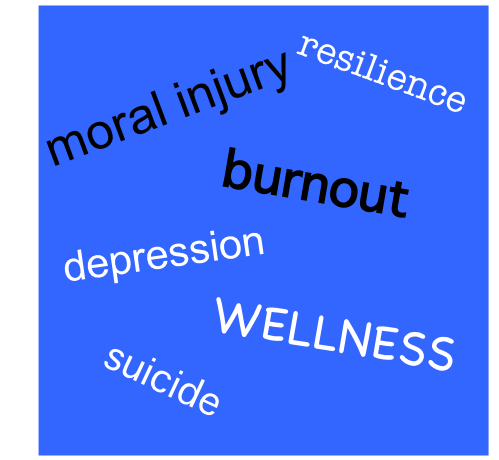Physician burnout
 Physician burnout has been in the news for the past few years. Defined as a sense of physical and emotional collapse related to work stresses, symptoms include exhaustion, cynicism, feelings of incompetence and poor work performance. In a survey of 6,880 physicians in 2014, 54.4% reported at least 1 symptom of burnout (up from 45.5% in 2011) and the numbers are continuing to rise. A systematic review summarizing articles written about physician burnout suggests that burnout can also lead to an increase in medical errors. Among the suspected causes of burnout are the pressures of seeing more patients in less time, the challenges of documenting clinical visits in an electronic health record, increasing paperwork required by insurance companies, etc. In short, the demands of a fragmented, dysfunctional healthcare system are thought to be an important contributor to the suffering experienced by physicians.
Physician burnout has been in the news for the past few years. Defined as a sense of physical and emotional collapse related to work stresses, symptoms include exhaustion, cynicism, feelings of incompetence and poor work performance. In a survey of 6,880 physicians in 2014, 54.4% reported at least 1 symptom of burnout (up from 45.5% in 2011) and the numbers are continuing to rise. A systematic review summarizing articles written about physician burnout suggests that burnout can also lead to an increase in medical errors. Among the suspected causes of burnout are the pressures of seeing more patients in less time, the challenges of documenting clinical visits in an electronic health record, increasing paperwork required by insurance companies, etc. In short, the demands of a fragmented, dysfunctional healthcare system are thought to be an important contributor to the suffering experienced by physicians.
Peter Ubel points out in a recent article that US physicians are required to document much more than doctors in other countries, spending almost half of clinical appointment time on documenting the severity of illness (to justify the amount being billed) and proving that they have engaged in tracking quality-of-care measures established by payers.
Suggested interventions for managing physician burnout have included meditation, yoga, mindfulness training and relaxation techniques but most people agree that these interventions are not getting to the root cause of the problem. Resilience training has also been proposed but puts the blame for the burnout on the physician.
One article suggests that, rather than burnout, what physicians are actually experiencing is “moral injury”. The term moral injury was first used to describe soldiers at war – the feeling of being called upon to act in ways that go against your moral beliefs. For physicians, the moral injury is the inability to provide the high quality of care and healing they went into medicine to provide. They feel like they are stuck between trying to make administrators happy (by seeing more patients in less time) and trying, unsuccessfully, to meet the needs of patients. Physicians recognize that their patients are not getting the best care as a result of the dysfunctional healthcare system but they also feel powerless to address the social factors like lack of housing or family stress that may be contributing to physical illness in some patients.
The situation is complicated by the fact that physicians have traditionally been trained to work hard and to be objective and unemotional, so any feeling of inadequacy or work anxiety feels like failure. Physicians keep the feelings to themselves causing an even greater sense of isolation.
Medical schools, physician training programs and health systems are also concerned about the rise in student and physician suicide. In fact, a documentary, Do No Harm, is focused on this issue. We don’t know for sure that the increase is suicide is the result of burnout but they are likely related problems.
The solution to physician burnout goes well beyond mindfulness training. In fact, healthcare organizations need to become more mindful themselves by understanding the stress of clinicians and finding ways to address it. They also need to encourage physicians to acknowledge their frustrations and talk about them, without fear of criticism. And, as Sachin Jain argues, they could make a concerted effort to express genuine appreciation to physicians and to encourage patients to do so as well.
We have a lot of work to do to prevent and manage physician burnout. The health of patients requires that we figure this out. And healthcare organizations need to examine their own role in its cause.
0 thoughts on “Physician burnout”